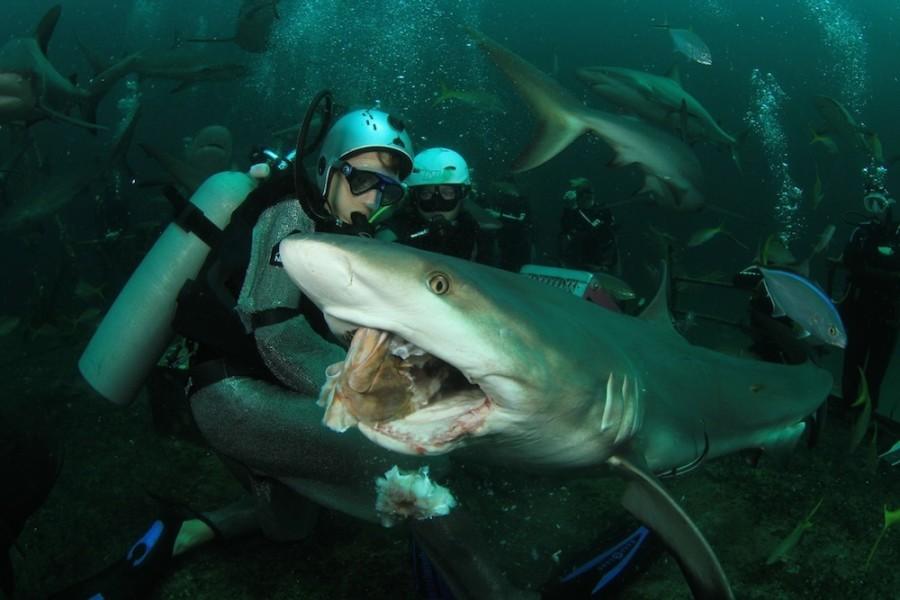Danger Below
Freshman holds two world records
Goh Iromoto / Provided by Braden Snow
January 29, 2015
Diving deep into the Atlantic Ocean, he feeds some of the worlds most feared sea creatures: sharks.
Freshman Braden Snow first began shark feeding at the young age of ten.
“Growing up, my dad used to always dive and feed sharks and I’ve always wanted to do it, so he just kind of inspired me to do it,” Braden said.
Braden has been a certified diver since he was ten, and travels to Nassau, Bahamas every summer. In order to dive, he first has to put on the proper gear before getting in the water, which usually takes around thirty minutes.
“Usually what I do is I put on my wet suit and then I put on my BCD vest [Buoyancy Control Device] and then I strap everything in, and then I put my correct weight setting so I don’t float to the surface or sink,” Braden said. “And then what I usually do after that is put on the chain mill; it’s what protects me if I did get bit. It protects me because the shark’s teeth get caught in it, and it’s kind of like armor.”
Although Braden is accompanied by professional divers, sometimes gear and supervision just can’t compete with the inevitable. One time, Braden was simply in the wrong place at the wrong time.
“All I remember is, I was going to feed this one shark and then they just all kind of cluttered up. This one got stuck between all the sharks and then swung its head and hit my mask and I fell backwards,” Braden said. “Then they [the other divers] picked me up and carried me to the surface. I wasn’t knocked out, I mean it was a mild concussion, but I couldn’t surf again that day.”
He is also known for holding two world records: The first being the world’s youngest shark feeder (age 10), and the second being the world’s youngest to put a shark into tonic immobility (age 12).
“It’s basically putting a shark to sleep,” Braden explains. “Since they have electrical fields on their noses kind of to help them find fish, if you rub their noses, it kind of paralyzes them and puts them into a sleep so you can lay them down and pet them. But you have to always rub their nose.”
After Braden broke the record for the world’s youngest shark feeder, his father received an email from Stewart Cove, a dive shop owner in the Bahamas saying that Braden had broken his daughter’s record.
“The bad thing about it was that they didn’t put it in the World Records because they didn’t want me to inspire kids to do something dangerous,” Braden said. “If you really go down there and experience the things that I get to experience, I would definitely encourage kids to do it. Sharks aren’t really what they seem like. There’s all these shows about how people are attacked, but when you’re down there and just get to interact with them in a close way, it really just doesn’t come across my mind how dangerous they are.”
One of the coolest things Braden admits to have experienced was when he went to Cat Island, Bahamas and swam with White Tip Sharks, along with meeting Andy Casagrande, a National Geographic field producer and cinematographer.
“He’s really popular on Shark Week, so he found out about me and I just got a lot of publicity from that, and I actually got to meet him and meet all these really cool people, too.”
The producers of the show, Shark Week, emailed Braden’s dad and asked if he could be on the show. He plans to travel to Bimini, Bahamas in May to be filmed swimming with Great Hammerhead sharks, as well as Nassau, Bahamas to continue filming him feeding.
“They’re also going to interview me on the Shark After Dark talk show that they do on Shark Week, so I’m excited for that,” Braden said.
He says he would like to get into underwater photography or filming when he gets older, or maybe even marine biology to study the ocean.
“When I tell people about everything that I do, I hope it puts an impact on them because it’s something I really care about and enjoy,” Braden said. “Every summer I go, it’s just a different experience.”




